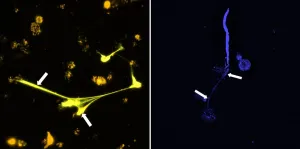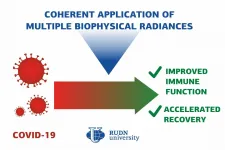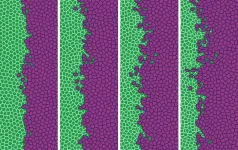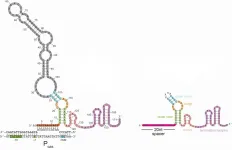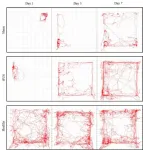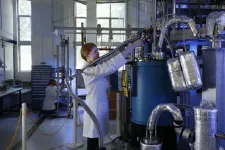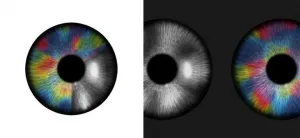(Press-News.org) Filariae, slender but sometimes up to 70 centimeters long nematodes, can set up residence in their host quite tenaciously and cause serious infectious diseases in the tropics. The tiny larvae of the worms are usually transmitted from person to person by mosquitoes, which pick up the larvae from the blood or subcutaneous tissue when they bite and deposit them in the vessels or tissues of their next victim. Researchers led by the University of Bonn (Germany) have now investigated a mechanism by which the immune system attacks the filariae. Certain immune cells, the eosinophil granulocytes, release DNA that forms a kind of web around the larvae and traps them. The researchers also identified which protein "turns on" the mechanism, known as the Dectin-1 receptor. The study has been published in the journal Cell Reports.
At first, the nematodes release the larvae directly in the tissues of their host; these are less than a millimeter in size and are therefore called microfilariae. But to continue developing and become infectious, the larvae need the help of mosquitoes. These ingest the host microfilariae with the blood meal. The larvae continue to develop in the insect's body and re-enter humans with the next bite. Filariae can cause severe diseases such as river blindness or elephantiasis (extreme lymphatic swelling in the legs and/or testicles), which belong to the so-called neglected tropical diseases (NTDs) and are found in about 80 million people there.
To investigate which mechanisms the immune system uses against such invaders, in their study the researchers took a closer look at certain immune cells, the eosinophil granulocytes. These cells get their name from the red dye eosin, with which they can be stained. "Eosinophil granulocytes are known to offer a protective effect in filarial infections. However, the exact mechanism was not known until now," says study leader Prof. Marc P. Hübner from the Institute of Medical Microbiology, Immunology and Parasitology at the University Hospital Bonn and the German Center for Infection Research (DZIF).
The methods by him the researchers included molecular biology and immunofluorescence microscopy to determine and measure the occurring DNA. Using cell cultures, they found that eosinophils reacted to nematode larvae - the cells produced DNA, which then spun around the larvae outside the cell like a web. This meant that the larvae could move only with difficulty or not at all and were thus rendered harmless. The mechanism occurred both in released larvae (first larval stage) and in more developed larvae at an already infectious stage (third larval stage). This could reduce the spread of the parasites, because the transmitting insects subsequently encounter fewer microfilariae. In addition, the infective larvae transmitted by the insect are more effectively controlled in the final host.
A subsequent experiment with mice also confirmed the researchers' observation that DNA webs enhance the removal of microfilariae. Conversely, mice lacking eosinophil granulocytes did not form DNA webs against larvae.
The mechanism by which immune cells develop such DNA webs is called ETosis - ET stands for extracellular traps. The process of ETosis has been known for some time, but has so far been investigated mainly in other immune cells, the neutrophil granulocytes.
Receptor recognizes larvae and triggers protective mechanism
But what makes cells recognize the threat of larvae and release DNA webs? The researchers concluded that it is a specific protein on the cell surface, the Dectin-1 receptor. When the cells come into contact with the worm larvae, it is set in motion and triggers the mechanism, which consists of a series of successive signals. The researchers were also able to identify the parts of the cell from which the released DNA originates: The primary source are the mitochondria, the "power plants" of the cells. But DNA was also fed into the webs from the cell nucleus, where it was released by biochemical changes.
"Our results demonstrate that eosinophil ETosis is a conserved mechanism. This is demonstrated by the fact that both human and animal eosinophil granulocytes are able to release their DNA when they come into contact with filariae of different species," emphasizes lead author Dr. Alexandra Ehrens from the University of Bonn.
The results of the study may in future contribute to finding strategies against the spread of diseases caused by filariae. In follow-up studies, the researchers want to investigate the relevance of the discovered defense mechanism for the control of such filariae in Africa.
INFORMATION:
Participating institutions:
In addition to the University of Bonn and the DZIF in Bonn, the study was conducted by the Muséum National d'Histoire Naturelle in Paris (France) and the company Elanco Animal Health in Monheim. Marc Hübner is also a member of the Transdisciplinary Research Area (TRA) "Life and Health" at the University of Bonn. In six different TRAs, scientists from a wide range of faculties and disciplines come together to work on future-relevant research topics.
Publication: Alexandra Ehrens, Benjamin Lenz, Anna-Lena Neumann, Samuela Giarrizzo, Julia Jennifer Reichwald, Stefan Julian Frohberger, Wiebke Stamminger, Benedikt Christian Buerfent, Frédéric Fercoq, Coralie Martin, Daniel Kulke, Achim Hoerauf & Marc Peter Hübner: Microfilariae Trigger Eosinophil Extracellular DNA Traps in a Dectin-1-Dependent Manner. Cell Reports; DOI: 10.1016/j.celrep.2020.108621
Link to study: https://www.cell.com/cell-reports/pdf/S2211-1247(20)31610-7.pdf
Our brains experience significant changes in blood flow and neural activity during sleep, according to Penn State researchers. Such changes may help to clean out metabolic brain waste that builds up during the day.
"We studied the sleep patterns of mice during both rapid eye movement and non-rapid eye movement sleep stages, as well as in different alertness states," said Patrick Drew, Huck Distinguished Associate Professor of Engineering Science and Mechanics, Neurosurgery and Biomedical Engineering.
Mice were chosen for the study because of their brains' remarkable similarity with human brains, said the researchers.
In both mice and humans, non-REM sleep ...
A team of researchers from RUDN University and RLT suggested restoring normal levels of lymphocytes in patients with COVID-19 and other viral diseases by subjecting them to the combined influence of light, magnetic field, and ultrasound. The results of the study were published in the Journal of Photochemistry and Photobiology B: Biology.
Some COVID-19 patients are asymptomatic, while others suffer from complications. To effectively fight coronavirus with drugs and therapeutic methods, scientists and medics have to find out what causes these differences in the course of the disease. A team of scientists from RUDN University together with their colleagues from the international company Radiant Life Technologies (RLT) suggested that the reason might ...
A scientific study carried out by the Universidad Carlos III de Madrid (UC3M) and the Universidad Complutense de Madrid (UCM) has produced a mathematical description of the way in which a tumor invades the epithelial cells and automatically quantifies the progression of the tumor and the remaining cell islands after its progression. The model developed by these researchers could be used to better understand the biophysical characteristics of the cells involved when developing new treatments for wound healing, organ regeneration, or cancer progression.
This research analyses the collective ...
An Academic Analytics Research Center (AARC) study has found greater rates of authorship of open access (OA) research articles among scholars at more prestigious institutions with greater access to resources and job security. "The open access publishing model is growing, and open access successfully democratizes the results of research projects, but it's clear now that some scholars are more likely to be represented in the open access literature" said AARC director and lead author of the study Anthony Olejniczak, Ph.D.
The researchers analyzed characteristics of 182,320 open access authors at American research universities from 2014 through 2018. The study ...
In a series of experiments with laboratory-cultured bacteria, Johns Hopkins scientists have found evidence that there is a second role for the widely used gene-cutting system CRISPR-Cas9 -- as a genetic dimmer switch for CRISPR-Cas9 genes. Its role of dialing down or dimming CRISPR-Cas9 activity may help scientists develop new ways to genetically engineer cells for research purposes.
A summary of the findings was published Jan. 8 in Cell.
First identified in the genome of gut bacteria in 1987, CRISPR-Cas9 is a naturally occurring but unusual group of genes with a potential for cutting DNA sequences in ...
Cerebral infarction, commonly known as ischemic stroke, has a high mortality rate and causes severe damage to nervous cells in the brain owing to the loss of oxygen, which results in limiting body movements. Several technologies, including physiotherapy and brain stimulation techniques, are being developed and tested for the rehabilitation of brain nervous cells damaged by a stroke. In particular, low-intensity focused ultrasound is expected to be effective for rehabilitating neurological diseases such as stroke, as it can excite or inhibit nerve cells by delivering mechanical energy with high precision at the desired position, while ultrasound is penetrating the cranium without requiring a surgical operation.
Korea Institute of Science and Technology (KIST) announced that the research ...
Why is studying spin properties of one-dimensional quantum nanowires important?
Quantum nanowires-which have length but no width or height-provide a unique environment for the formation and detection of a quasiparticle known as a Majorana zero mode.
A new UNSW-led study overcomes previous difficulty detecting the Majorana zero mode, and produces a significant improvement in device reproducibility.
Potential applications for Majorana zero modes include fault-resistant topological quantum computers, and topological superconductivity.
MAJORANA FERMIONS IN 1D WIRES
A Majorana fermion is a composite particle that is its own antiparticle.
Antimatter explainer: Every fundamental particle has a corresponding antimatter particle, with ...
A KAIST team's mathematical modelling shows that the topographic tiling of cortical maps originates from bottom-up projections from the periphery.
Researchers have explained how the regularly structured topographic maps in the visual cortex of the brain could arise spontaneously to efficiently process visual information. This research provides a new framework for understanding functional architectures in the visual cortex during early developmental stages.
A KAIST research team led by Professor Se-Bum Paik from the Department of Bio and Brain Engineering has demonstrated that the orthogonal organization of retinal mosaics in the periphery is mirrored onto the primary visual cortex and initiates ...
Overview:
Third-year doctoral student Toshiaki Takahashi, associate professor Kazuhiro Takahashi, and their research team from the Department of Electrical and Electronic Information Engineering at Toyohashi University of Technology developed a testing chip using semiconductor micro-machining that can detect volatile gasses in exhaled breath in ppm concentrations at room temperature. A polymer that expands and contracts when gas is absorbed is formed on a flexibly deformable nanosheet, and the amount of deformation that occurs when a target gas is absorbed is measured, allowing gas to be detected at high sensitivity. ...
New research shows that patterns inspired by lobster shells can make 3D printed concrete stronger, to support more complex and creative architectural structures.
Digital manufacturing technologies like 3D concrete printing (3DCP) have immense potential to save time, effort and material in construction.
They also promise to push the boundaries of architectural innovation, yet technical challenges remain in making 3D printed concrete strong enough for use in more free-form structures.
WATCH AND EMBED THE VIDEO: https://youtu.be/mpPAPlst42o
In a new experimental study, researchers at RMIT University ...
